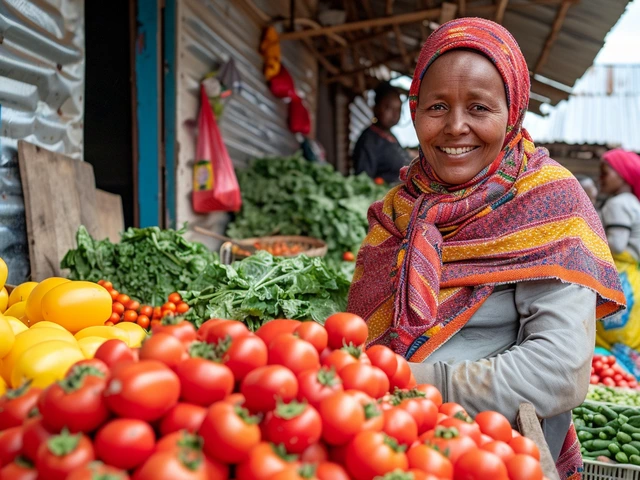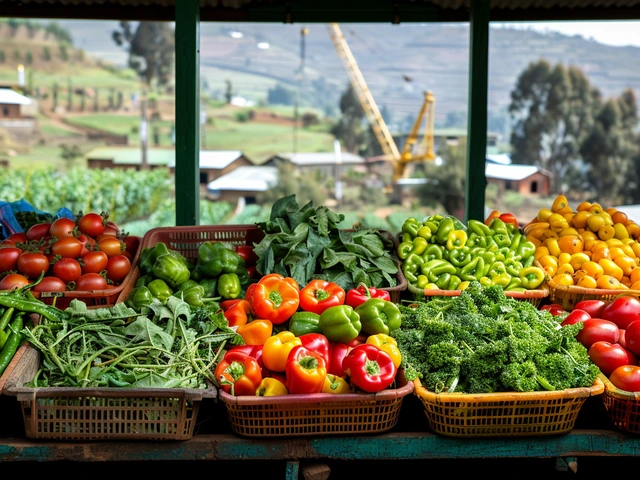A Deep Dive into Ethiopia's Prime Exports
Embarking on an expedition to unravel the core of Ethiopia's export economy is akin to weaving through the vibrant tapestries that adorn its markets. Central to this narrative is the famed Ethiopian coffee, which not only captivates palates worldwide but also anchors the nation's agricultural exports. But our gaze doesn't stop there; we venture beyond the coffee plantations to explore a burgeoning textile industry, fast becoming a global contender, and delve into the nascent but promising sectors poised to redefine Ethiopia's export landscape.
Coffee, the quintessence of Ethiopian trade, has a story that transcends mere commerce. It's a tale of heritage, of centuries-old traditions that have culminated in a product sought after globally. The Arabica beans, nurtured in Ethiopia's highlands, account for the lion's share of the country's exports, weaving a rich narrative of socioeconomic impact.
Yet, this narrative is enriched with the threads of other commodities. The textile and garment industry, for instance, is on an upward trajectory, driven by government incentives and an enticing investment climate. This sector, emblematic of Ethiopia's industrial ambitions, underscores a strategic pivot towards manufacturing, aimed at diversifying its traditionally agriculture-centric economy.
Then there's the burgeoning floriculture sector, where Ethiopia's favorable climatic conditions have birthed a flourishing industry. Here, roses, carnations, and other blooms are meticulously cultivated for markets far beyond its borders, adding vibrant hues to the nation's export palette.
However, challenges loom on the horizon. Infrastructure deficits, regulatory hurdles, and the pressing need for technological adoption are persistent thorns in the side of these promising sectors. The journey towards economic diversification and export-led growth is fraught with obstacles, but the resilience and ingenuity of the Ethiopian spirit offer a beacon of hope.
From Beans to Threads: Unraveling Economic Impact
The transformative power of exports on Ethiopia's economy cannot be overstated. Coffee, textiles, and floriculture not only account for significant foreign exchange earnings but also play pivotal roles in job creation and rural development. The spillover effects into related sectors such as logistics, packaging, and retail further amplify their impact, weaving a complex web of economic interdependencies.
The coffee sector, in particular, is a powerhouse of socio-economic development. Supporting millions of smallholder farmers, this industry is a lifeline for a significant portion of the population. The fair-trade movement and organic certification have added value, enabling Ethiopian coffee to command premium prices on the world stage. Yet, the maximization of this potential is contingent upon addressing deep-seated challenges in production, quality control, and global market fluctuations.
The textile industry's ascent, fueled by foreign investment and competitive labor costs, heralds a new era for Ethiopia's industrial sector. Special Economic Zones (SEZs), tailored incentives, and a strategic location are knitting a compelling narrative for international investors. But achieving a competitive edge in the global textile market demands relentless focus on skill development, quality assurance, and sustainability practices.
Similarly, the floriculture sector's exponential growth has positioned Ethiopia among the top flower exporters globally. This success story exemplifies the potential of high-value agricultural exports, provided there is continuous investment in cold chain logistics, quality standards, and market diversification.
Yet, the tapestry of Ethiopia's export economy is not without its frayed edges. Ensuring sustainable growth necessitates a holistic approach that addresses environmental concerns, bolsters infrastructure, and fosters innovation. The stakes are high, but the rewards—poised to propel Ethiopia towards middle-income status—are well within reach, with concerted efforts from both public and private sectors.
Woven into the Fabric of the Future: Emerging Sectors
As Ethiopia continues to chart its economic trajectory, attention is increasingly turning towards sectors that, while currently nascent, hold immense promise for the future. Renewable energy, technology, and agro-processing are emerging as new frontiers that could redefine Ethiopia's export identity beyond its traditional staples.
The country's abundant renewable energy potential, particularly in hydro, wind, and solar power, presents an untapped reservoir that could fuel not only domestic growth but also a green export economy. The lure of sustainable energy projects, coupled with Ethiopia's commitment to carbon neutrality, positions it as an attractive destination for green investments.
In the realm of technology, Ethiopia's burgeoning tech scene—dubbed 'Sheba Valley'—is indicative of the dynamic innovation reshaping the economy. Fostering a thriving startup ecosystem, particularly in fintech and agricultural technology, could catapult Ethiopia onto the global tech stage, transforming it into an exporter of digital services and solutions.
Agro-processing offers another avenue for diversification, adding value to traditional agricultural exports and reducing post-harvest losses. By harnessing Ethiopia's agricultural bounty, this sector could leapfrog into value-added products destined for international markets, bolstering food security and elevating the role of smallholder farmers in the global value chain.
The road ahead is dotted with both opportunities and obstacles. Investment in education, research, and infrastructure is imperative to cultivate these emerging sectors. Leveraging public-private partnerships, fostering innovation, and ensuring inclusivity will be critical in weaving these new threads into the robust fabric of Ethiopia's export economy.
In conclusion, Ethiopia's journey towards export-led growth is a multifaceted saga of resilience, innovation, and strategic foresight. As the nation continues to navigate the complexities of the global market, its export economy—rooted in tradition yet keenly attuned to the future—stands as a beacon of potential for the entire continent.

 Understanding the Average Work Week in Ethiopia: Insights and Facts
Understanding the Average Work Week in Ethiopia: Insights and Facts
 Is Ethiopia the Richest Country in Africa? Exploring Its Economic Potential and Growth
Is Ethiopia the Richest Country in Africa? Exploring Its Economic Potential and Growth
 Earning Strategies in Ethiopia: Innovative Ways to Make Money
Earning Strategies in Ethiopia: Innovative Ways to Make Money
 Best Investment Opportunities in Ethiopia 2024: A Comprehensive Guide
Best Investment Opportunities in Ethiopia 2024: A Comprehensive Guide
 Exploring Common Occupations in Ethiopia: Agriculture, Technology, and Beyond
Exploring Common Occupations in Ethiopia: Agriculture, Technology, and Beyond
Douglas Gnesda
April 4, 2024 AT 01:02When dissecting Ethiopia's export architecture, one must first calibrate the macro‑economic variables that scaffold its commodity mix. The coffee sector, anchored by Coffea arabica, contributes roughly 30 % of total foreign exchange earnings, a figure that eclipses many East African peers. Leveraging comparative advantage, Ethiopian smallholders export premium‑grade beans that command a risk‑adjusted price premium in specialty markets. Simultaneously, the nascent textile value chain benefits from a labor cost index that sits 15 % below the regional average, catalyzing foreign direct investment inflows. The government’s establishment of Industrial Parks, coupled with a 10‑year tax holiday, has created a quasi‑incubator environment for vertically integrated garment manufacturers. Moreover, Floriculture, often the unsung hero, accounts for an estimated $300 million in annual export revenue, driven by high‑value bouquets destined for European florists. From a supply‑chain perspective, the under‑investment in cold‑chain logistics remains a bottleneck that caps the scalability of perishable goods. Infrastructure upgrades, particularly the Addis Ababa–Djibouti rail corridor, are projected to reduce freight costs by up to 20 % within the next five years. On the policy front, Ethiopia’s participation in the African Continental Free Trade Area (AfCFTA) unlocks preferential market access across 54 economies, a strategic lever for diversification. Human capital development is also pivotal; vocational training programs in textile engineering have already upskilled over 12 000 workers. Environmental sustainability cannot be an afterthought: the coffee sector’s push towards shade‑grown agroforestry mitigates deforestation risks while enhancing bean quality. Renewable energy prospects, especially hydro‑electric capacity expansions, promise to decarbonize manufacturing footprints and attract ESG‑focused investors. Digitalization initiatives, such as the adoption of ERP systems by garment exporters, streamline inventory management and improve order fulfillment rates. In sum, Ethiopia stands at a crossroads where coordinated investment in logistics, human capital, and green technologies can transform its export basket from primary commodities to high‑value manufacturing. The trajectory ahead will hinge on policy coherence, private sector agility, and resilient farmer networks.
Abhijit Pimpale
April 9, 2024 AT 04:49The data suggests Ethiopia's export growth is uneven; coffee remains dominant while textiles lag behind due to capacity constraints. Addressing infrastructure gaps will be essential for sustained diversification.
Eric DE FONDAUMIERE
April 14, 2024 AT 08:37Wow, this deep dive really opens up the whole picture-Ethiopia is defiantly poising itself as a trade powerhouse! The energy behind teh textile push is contagious, even if the numbers sometimes feel a tad overwhelming.
Pauline Herrin
April 19, 2024 AT 12:24While the article admirably catalogs Ethiopia's export sectors, it insufficiently addresses the macro‑economic volatility that could undermine these gains. A more rigorous analysis of currency depreciation and fiscal deficits would render the discussion more comprehensive.
pradeep kumar
April 24, 2024 AT 16:12The optimism feels forced; without concrete data on export volume trends, the narrative remains speculative.
love monster
April 29, 2024 AT 19:59Great overview! The synergy between coffee’s premium branding and textile’s cost competitiveness could indeed create a virtuous cycle, especially if investors continue to leverage Ethiopia’s strategic location.
Christian Barthelt
May 4, 2024 AT 23:47Actually, the so‑called “government incentives” often mask bureaucratic red tape that deters rather than attracts investment, so the rosy picture may be overstated.
Ify Okocha
May 10, 2024 AT 03:34This piece glosses over the systemic corruption that throttles export efficiency; ignoring such realities renders the analysis shallow and misleading.
William Anderson
May 15, 2024 AT 07:22The discourse descends into pedestrian platitudes, failing to capture the nuanced geopolitics that dictate Ethiopia's trade corridors; one expects more sophistication from such a treatise.
Sherri Gassaway
May 20, 2024 AT 11:09Existence mirrors trade, each export a metaphor for aspiration.
Milo Cado
May 25, 2024 AT 14:56I'm thrilled to see Ethiopia's diversification momentum! 🌍🚀 The blend of heritage coffee and modern textiles paints a promising future, and the renewable energy push adds that extra spark. 😊
MONA RAMIDI
May 30, 2024 AT 18:44Honestly, this article feels like a lukewarm press release-no deep dive, no real insight, just surface‑level hype.
grace riehman
June 4, 2024 AT 22:31Hey folks, great read! Just wanted to add that Ethiopia’s coffee cooperatives also empower women farmers, which is a crucial piece of the social impact puzzle.
Vinay Upadhyay
June 10, 2024 AT 02:19Oh, brilliant, another glorified brochure about “emerging sectors.” As if hydro‑power and fintech will magically solve Ethiopia’s logistical nightmares overnight. The reality is that inadequate grid infrastructure and a nascent regulatory framework will choke these ambitions. Yet, the article blissfully sweeps these constraints under the rug, betting on investor optimism. In short, it’s a charmingly naive PR piece.
Eve Alice Malik
June 15, 2024 AT 06:06One notable development is the recent partnership between Ethiopian textile firms and German engineering firms, aiming to introduce automated looms that could triple production efficiency within three years.
Debbie Billingsley
June 20, 2024 AT 09:54Ethiopia’s export renaissance should be celebrated as a triumph of African self‑reliance, proving that we no longer need to bow to Western market dictates.
Patrick Van den Berghe
June 25, 2024 AT 13:41Impressive growth but watch the policy shifts
Josephine Gardiner
June 30, 2024 AT 17:29The comprehensive analysis presented herein elucidates the multifaceted dynamics underpinning Ethiopia’s export diversification, offering a scholarly perspective that may inform future policy deliberations.
Jordan Fields
July 5, 2024 AT 21:16Infrastructure deficits remain the principal obstacle to scaling Ethiopia’s export potential.
Divyaa Patel
July 11, 2024 AT 01:02In the grand tapestry of global trade, Ethiopia weaves a bold, crimson thread-vivid, defiant, and destined to reshape the economic horizon.